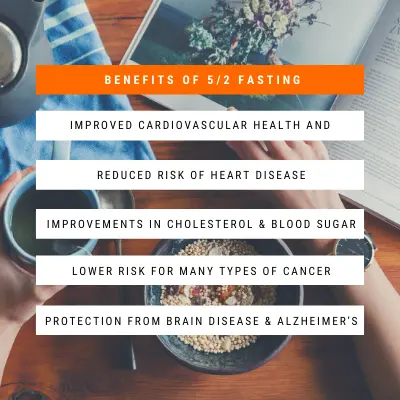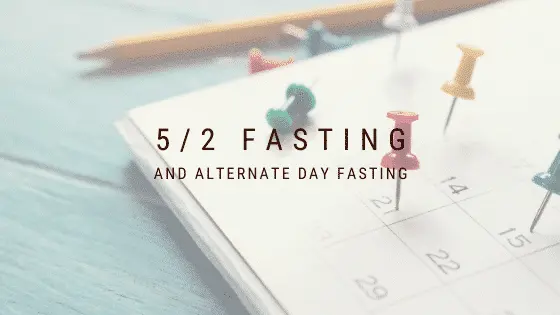Fasting , particularly the 5/2 Diet, has become so popular in recent years that there are nearly endless ways to incorporate fasting into your life. Some people thrive best with time-restricted eating on a daily basis and others like to do the occasional prolonged fast.
Many people like a mix between the two, so in this article, we’re going to discuss the merits and drawbacks of 5/2 fasting and other types of alternate-day fasts.
What Is The 5:2 Diet?
The 5/2 Diet is a way of structuring your weekly caloric intake so that you eat normally for 5 days our of the week and restrict your eating on the remaining 2 days of the week. Usually, the 2 days of fasting are separated within the week, on a Monday and Thursday or Wednesday and Sunday, for example, depending on what works in your personal schedule.
The diet was originally introduced by Dr. Michael Mosley, who has been using his medical training as a presenter and journalist for the BBC since the 80s. He has also written an impressive collection of books, including The Fast Diet, which was the introduction for the 5/2 way of eating.
In his plan, you don’t actually restrain from eating entirely on the 2 fasted days per week, but instead, you simply limit your calories to 500 – 600 maximum. There are no restrictions about what you eat or when you eat, so long as you follow the calorie restrictions.
Many people find this type of diet easier to follow than other diets that force you to count calories every day or limit what types of food you eat.
The good doctor has introduced more extreme versions of this diet recently to help with faster weight loss. The Fast 800 encourages dieters to restrict their calories to 800 per day for between 2 – 12 weeks to lose the maximum amount of weight possible before transitioning to The New 5:2, which is the same layout as the original, but with the fasting-mimicking days allowing up to 800 calories and encouraging you to follow a Mediterranean diet as a way of life.
The attention to nutrition that is incorporated into The New 5:2 is applaudable, though 800 calories are not strictly considered a true fast.
How Does Alternate-Day Fasting Work?
In Alternate-Day Fasting (ADF), you fast completely one day, and then eat whatever and however much you want the next day. ADF is extremely easy to understand and follow if you have the determination to fast so frequently. You simply eat whatever you want, or you don’t eat at all.
If every second day is too extreme for you, you can modify your fast to include up to 500 calories per day on the fasting days.
Benefits of the 5:2 Diet and ADF
This particular style of fasting has shown to be very effective for weight loss results, but the most interesting factors are the type of weight that is lost. Studies have shown a consistent reduction in belly fat, which is known to be the most dangerous as it surrounds your vital organs. These same studies suggest that ADF is more protective of muscle mass than other forms of calorie restriction, and the weight loss is maintained more effectively over time.
Outside of weight loss, alternate day fasting and, in fact, almost all forms of fasting for at least 12 hours have shown long-term health benefits such as:
- Improved cardiovascular health, including a reduction in symptoms of asthma
- Reduced risk of stroke, high blood pressure, and heart disease
- Improvements in cholesterol and blood sugar balance
- Lower risk for many types of cancer
- Protection from brain disease and decline, such as Alzheimer’s

How much weight can you lose with alternate-day fasting?
There are many studies that have used different criteria and standards to evaluate the potential weight loss for ADF or the 5/2 Diet. Results will vary significantly depending on the health and starting weight of the individuals participating in the research, as well as their dietary guidelines outside of the fasted days. Their level of physical activity will also change the potential results, so it’s very difficult to give an exact estimation.
As an example, in trials conducted by Dr. Mosley for his very fast 800 diet, overweight individuals, with and without type 2 diabetics lost an average of 23 lbs in 12 weeks.
Is Alternate-day fasting safe?
For relatively healthy people of average weight, alternate day fasting, including the 5/2 fast, is completely safe. If you have any form of chronic illness or are significantly overweight, fasting can have the biggest impact on your health, but you must work with your doctor to establish a safe plan of action and consistent monitoring.
There are some people who should avoid fasting or calorie restriction of any type. If you fall into any of these categories, fasting may not be for you:
- Pregnant women and breastfeeding mothers, or women with PCOS or other fertility concerns
- Children under the age of 18, unless otherwise instructed by their primary care provider
- Type 1 diabetics should only ever attempt fasting under the extreme care and supervision of their doctor. Type 2 diabetics should also be carefully supervised.
- Anyone who has ever lived with an eating disorder
- Underweight individuals should approach fasting with caution
- Extreme athletes may find ADF too frequent to support their exercise habits and may be better suited to daily time-restricted eating or the occasional prolonged fast for health benefits
Alternate Day Fasting vs. Intermittent Fasting
Alternative day fasting (ADF) is a form of intermittent fasting (IF), however, IF often refers to a specific type of daily time-restricted eating, such as eating all your food for the day within a limited 8-hour window.
Both forms of fasting require dedication and commitment and can have serious long-term health benefits. They both rely heavily on routine and getting used to the pattern of not eating at certain times. Some people find ADF nearly impossible to commit to, though they don’t struggle with IF in the least. Others are the opposite. You will have to experiment to find your own ideal rhythm because ultimately, the best results will come from the routine you’re able to stick to.
If you’re interested in learning about more styles of fasting, you will probably learn a lot from our related post, Types of Fasting.




